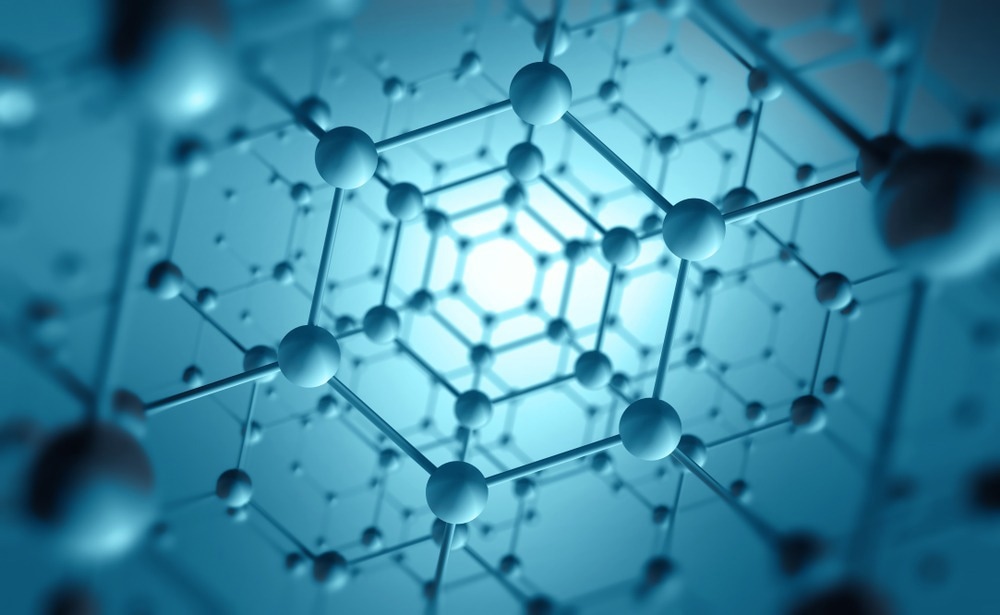Deterministic molecular stacking of two-dimensional substances with regulated symmetry remains a major challenge. A recent study published in The Journal of Physical Chemistry Letters addresses this issue by reporting a 30° twisted stacking of two-dimensional organic copper nanocluster assemblies.

Study: Enhanced Chemical Stability in the Twisted Dodecagonal Stacking of Two-Dimensional Copper Nanocluster Assemblies. Image Credit: Yurchanka Siarhei/Shutterstock.com
Two-dimensional (2D) materials have lately gained prominence owing to their superior characteristics when compared to typical bulk materials. Two-dimensional materials have a low weight, a high Young's modulus, a high strength, and a strong anisotropy between in-plane and out-of-plane mechanical characteristics.
Two-Dimensional Materials with Quasiperiodicity: A New Research Frontier
The development of two-dimensional substances with quasiperiodicity has piqued the curiosity of many researchers in recent years because of their multiple industrial applications. Surprisingly, studies on the production of two-dimensional nanomaterials with quasiperiodic structures remain scarce even after almost 40 years.
One explanation for this barrier is that such structures are still difficult to produce using accepted synthetic chemistry concepts. However, recent findings show that angular/twisted layering of two-dimensional materials with hexagonal structures may open up new possibilities for arranging crystallographic quasiperiodicity.
Twisted multilayer graphene, for instance, has been shown to produce quasicrystalline regularity when layered at a certain angle of 30°. Moreover, the identification of super conductance in magic-angle twisted bilayered and multilayered graphene increases the likelihood of discovering unexpected features in other two-dimensional compounds.
The existence of unique physical features in twisted two-dimensional materials is further highlighted by the Raman spectrum in twisted multilayered graphene and photonic rotations in twisted two-dimensional black phosphorus.
Quasicrystallinity of Two-Dimensional Nanoscale Structures
Two-dimensional nanoparticles are identified as suitable contenders for a higher-order structural organization with qausicrystallinity. As a result, there is a compelling argument for exploring the chemical reaction-based structural organization of two-dimensional materials.
The self-assembling of materials such as colloids, monomers, microemulsions, and nanomaterials into superstructures results in the creation of quasiperiodic symmetry, controlled mainly by entropy. On the other hand, truncated tetragonal quantum dots with directional patchiness have also been shown to create a 10-fold symmetrical quasicrystalline structure.
It is vital to emphasize that the aperiodic compositions that result in superlattice patterns are the consequence of the random tilting of two separate materials or a single component with the ability to adopt numerous forms. As a result, the creation of a quasicrystalline organization of a single component, such as uniform-sized two-dimensional nanomaterials, remains critical.
Twisted Stacking of Novel Two-Dimensional Copper Nanoclusters
Molecular nanoclusters, particularly those of minted metal, are an interesting example of the twisted stacking of nanomaterials into superstructures. This is because ligand-stabilized metallic nanoclusters can crystallize into larger particles based on their interfacial interactions.
In this study, the researchers report that by adjusting the reaction mechanism, it is feasible to arrange ligand-stabilized molecular nanoclusters into structured two-dimensional nanoparticles with quasiperiodic symmetry.
The researchers combined metal ions and copper molecular clusters by reducing the number of metal ions introduced to the reaction media, resulting in twisted two-dimensional nanostructures with quasiperiodic symmetry.
A simple synthesis process was used to create copper nanoclusters (CuNCs) reinforced by mercaptobenzoic acid (MBA) and mercaptopropanoic acid (MPA). The as-prepared copper nanoclusters were subsequently complexed with zinc metal ions and formed into two-dimensional hexagonal nanostructures.
Important Findings of the Study
The luminescence strength of zinc-modified copper nanoclusters (CuNCs) increased significantly, indicating the establishment of a crystalline. The two-dimensional copper nanoclusters also showed hexagonal diffraction patterns in the selected area electron diffraction pattern (SAED) study.
This also confirmed the suggested hexagonal lattice of two-dimensional nanomaterials, in which CuNCs are placed in a consistent hexagonal pattern.
Transmission electron microscopy indicated the existence of dodecagonal symmetry areas with an apparent loss of translational symmetry. Photoluminescence tests revealed that the layered assembly formed in the liquid media. In the presence of molecular iodine, the as-synthesized twisted stacking morphology of two-dimensional CuNCs outperformed hexagonal crystals in prolonged photoluminescence and chemical stability.
It is anticipated that these findings will pave the way for future research into novel chemical and physical characteristics by designing layered assemblies of luminous or other two-dimensional materials.
More from AZoNano: Using Nanoparticles to Propel Proteomics Research
Reference
Das, P., & Chattopadhyay, A. (2022). Enhanced Chemical Stability in the Twisted Dodecagonal Stacking of Two-Dimensional Copper Nanocluster Assemblies. The Journal of Physical Chemistry Letters. Available at: https://pubs.acs.org/doi/10.1021/acs.jpclett.2c02300
Disclaimer: The views expressed here are those of the author expressed in their private capacity and do not necessarily represent the views of AZoM.com Limited T/A AZoNetwork the owner and operator of this website. This disclaimer forms part of the Terms and conditions of use of this website.